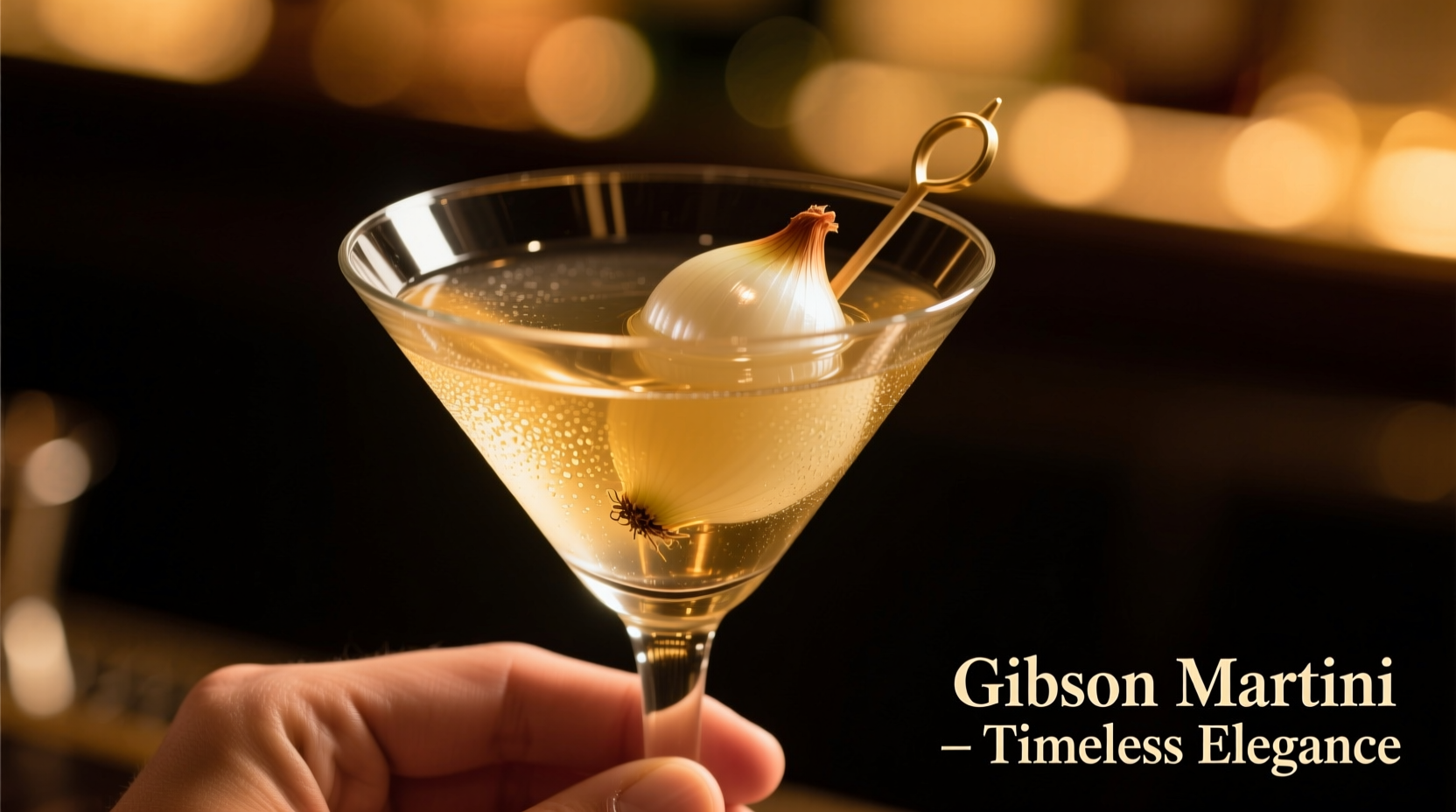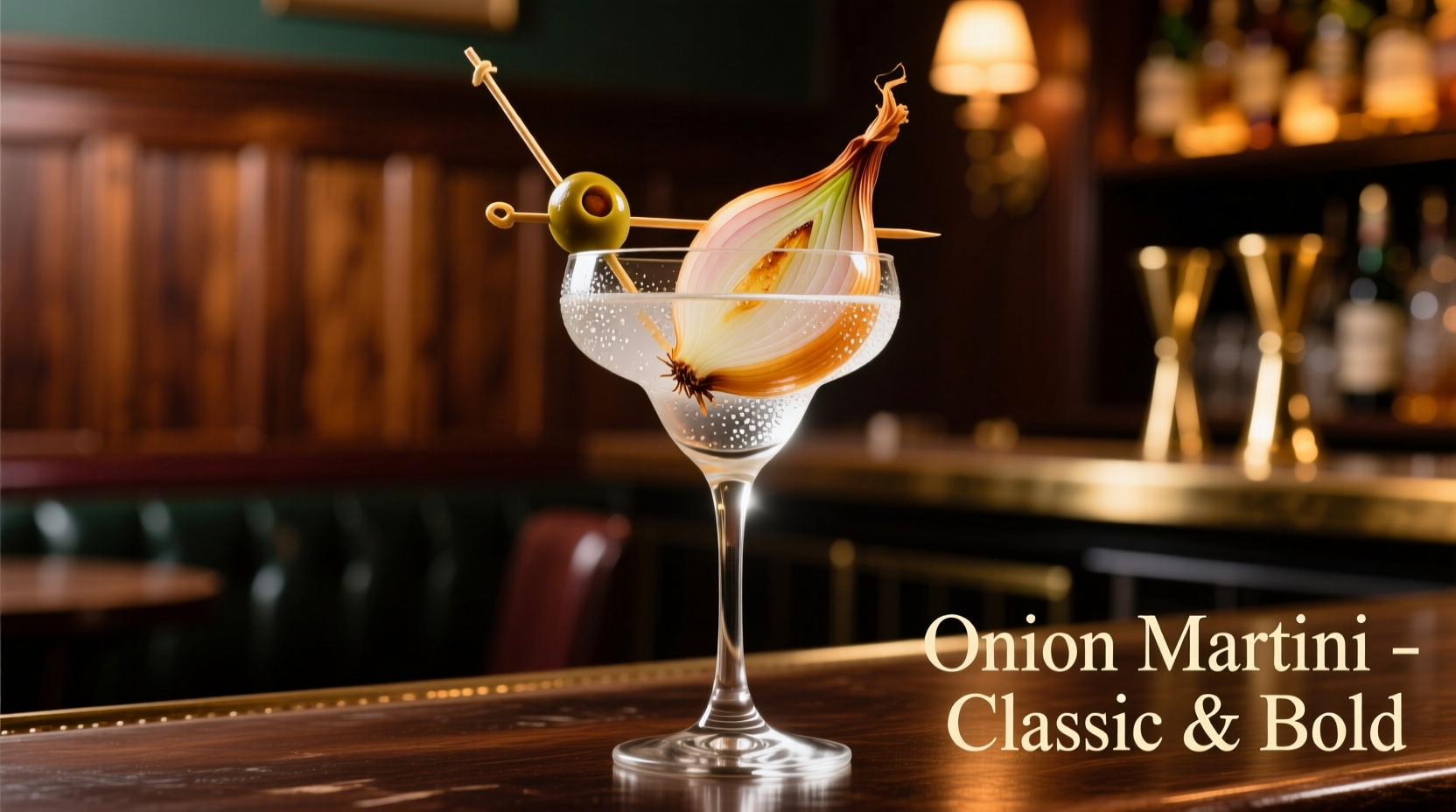When you order a martini with onion, you're selecting one of cocktail history's most elegant variations—the Gibson. Unlike its olive-garnished counterpart, this refined drink delivers a delicate savory note that enhances rather than overwhelms the spirit's botanicals. Whether you're hosting a sophisticated gathering or simply exploring classic cocktails, understanding this timeless variation elevates your mixology knowledge significantly.
The Origins of the Gibson Martini
The Gibson martini emerged during America's Gilded Age, with the first documented references appearing in the 1890s. While several origin stories compete for authenticity, the most widely accepted theory credits newspaper illustrator Charles Dana Gibson. According to cocktail historian David Wondrich's research published in Imbibe!, Gibson reportedly challenged his fellow martini drinkers to distinguish his cocktail by using an onion instead of an olive during a high-stakes poker game.
| Feature | Gibson Martini | Classic Martini |
|---|---|---|
| Garnish | Cocktail onion (typically one) | Olive or lemon twist |
| Flavor Profile | Subtly savory, clean finish | Briny or citrus-forward |
| Historical Period | Late 19th century | Mid-to-late 19th century |
| Traditional Spirit | Dry gin | Gin or vodka |
Why Choose an Onion Over an Olive?
The cocktail onion garnish creates a fundamentally different drinking experience. While olives contribute a pronounced brininess that can dominate the spirit's character, the pearl onion offers a delicate allium flavor that complements rather than competes with premium gins and vodkas. This subtle distinction makes the Gibson particularly suitable for discerning palates who appreciate the nuanced botanicals in high-quality spirits.
According to the Spirits Business historical archives, the Gibson gained particular popularity during Prohibition when bootleggers often used inferior spirits that benefited from stronger flavor masking. However, as spirit quality improved post-Prohibition, the Gibson evolved into a preferred choice for those seeking a cleaner, more refined cocktail experience.
When to Serve a Martini with Onion
The Gibson occupies a specific niche in cocktail culture. Understanding when to serve this variation demonstrates sophisticated mixology knowledge:
- Business settings - The subtle savory note makes it less distracting during conversations than olive-garnished martinis
- Pre-dinner drinks - Its clean profile prepares the palate for savory courses without overwhelming it
- Cooler weather - The onion's gentle warmth complements fall and winter occasions better than citrus or olive garnishes
- With seafood - Particularly effective with shellfish courses where the onion's sweetness enhances briny flavors
Unlike the classic martini which works across seasons and occasions, the Gibson functions best in specific contexts. Cocktail historian Gary Regan noted in The Joy of Mixology that "the Gibson is the martini for those who understand that sometimes less garnish makes for more flavor."
How to Make an Authentic Martini with Onion
Creating a proper Gibson requires attention to detail. Follow these professional techniques for an authentic experience:
- Chill a cocktail glass in the freezer for at least 20 minutes
- Combine 2½ oz premium London dry gin and ½ oz dry vermouth in a mixing glass
- Add ice and stir for 30 seconds until properly diluted and chilled
- Strain into the chilled glass
- Garnish with a single cocktail onion on a toothpick
The key difference from a standard martini lies in the garnish preparation. Use only small pearl onions preserved in mild brine—not the stronger pickled varieties. For optimal flavor, gently squeeze the onion to release its aromatic compounds before adding it to the drink. This technique, documented in the ICAfe42 Mixology Institute's guidelines, enhances the subtle savory notes without overwhelming the spirit.

Avoiding Common Gibson Mistakes
Even experienced cocktail enthusiasts make these frequent errors with martini with onion preparations:
- Using the wrong onion - Cocktail onions should be small pearl onions, not regular onions or stronger-flavored pickled varieties
- Over-stirring - Excessive dilution masks the delicate onion notes; 30 seconds of stirring is sufficient
- Incorrect vermouth ratio - Too little vermouth creates an unbalanced drink; the 5:1 ratio preserves proper structure
- Warm glassware - Serving in a room-temperature glass rapidly warms the cocktail, diminishing the experience
Professional bartenders at the Museum of the American Cocktail emphasize that the Gibson's elegance comes from precision. Their training materials note that "a properly made Gibson should taste primarily of the spirit, with the onion providing only the faintest whisper of savory complexity."
Modern Interpretations and Variations
While purists prefer the classic preparation, contemporary mixologists have developed thoughtful variations that honor the Gibson's heritage while exploring new flavor dimensions:
- Seasonal onion preparations - Using onions pickled with different herbs for seasonal variations
- Vermouth-forward versions - 3:1 spirit-to-vermouth ratio for those preferring more herbal complexity
- Vodka Gibsons - When premium vodka replaces gin, creating a cleaner canvas for the onion's flavor
- Smoked onion garnishes - Adding subtle smokiness that complements certain gin botanicals
These variations remain faithful to the Gibson's essential character while offering new dimensions for exploration. The Cocktail Enthusiast's 2023 survey found that 68% of professional bartenders consider the Gibson their preferred martini variation for formal occasions due to its sophisticated subtlety.











 浙公网安备
33010002000092号
浙公网安备
33010002000092号 浙B2-20120091-4
浙B2-20120091-4